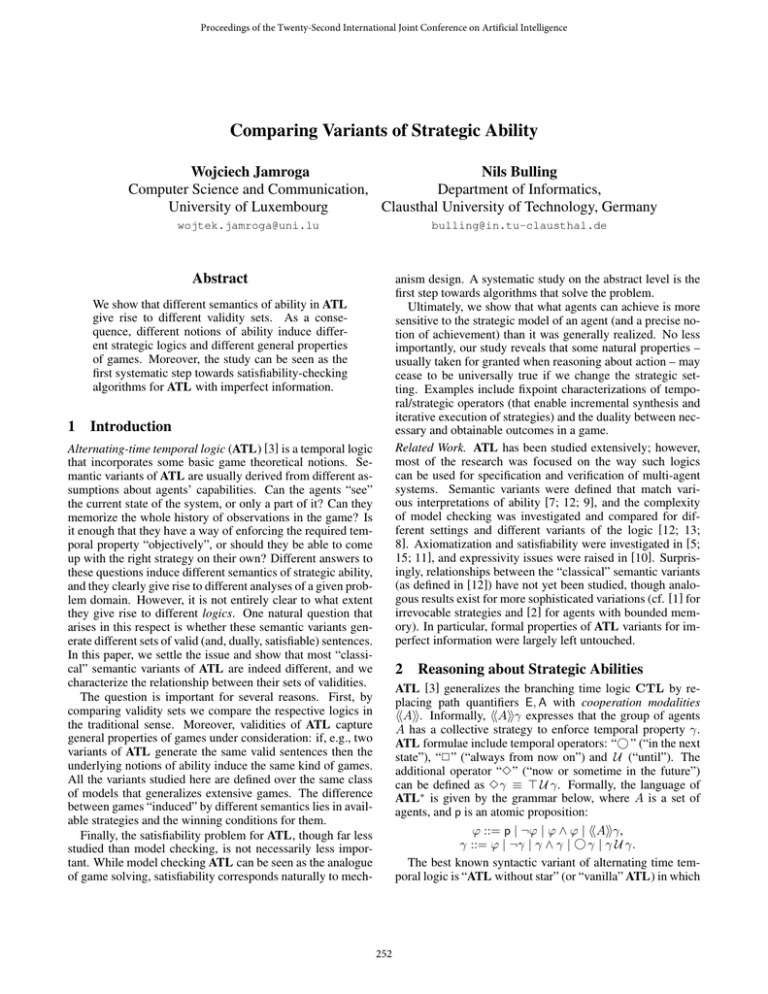Comparing Variants of Strategic Ability
advertisement

Proceedings of the Twenty-Second International Joint Conference on Artificial Intelligence
Comparing Variants of Strategic Ability
Wojciech Jamroga
Nils Bulling
Computer Science and Communication,
Department of Informatics,
University of Luxembourg
Clausthal University of Technology, Germany
wojtek.jamroga@uni.lu
bulling@in.tu-clausthal.de
Abstract
anism design. A systematic study on the abstract level is the
first step towards algorithms that solve the problem.
Ultimately, we show that what agents can achieve is more
sensitive to the strategic model of an agent (and a precise notion of achievement) than it was generally realized. No less
importantly, our study reveals that some natural properties –
usually taken for granted when reasoning about action – may
cease to be universally true if we change the strategic setting. Examples include fixpoint characterizations of temporal/strategic operators (that enable incremental synthesis and
iterative execution of strategies) and the duality between necessary and obtainable outcomes in a game.
Related Work. ATL has been studied extensively; however,
most of the research was focused on the way such logics
can be used for specification and verification of multi-agent
systems. Semantic variants were defined that match various interpretations of ability [7; 12; 9], and the complexity
of model checking was investigated and compared for different settings and different variants of the logic [12; 13;
8]. Axiomatization and satisfiability were investigated in [5;
15; 11], and expressivity issues were raised in [10]. Surprisingly, relationships between the “classical” semantic variants
(as defined in [12]) have not yet been studied, though analogous results exist for more sophisticated variations (cf. [1] for
irrevocable strategies and [2] for agents with bounded memory). In particular, formal properties of ATL variants for imperfect information were largely left untouched.
We show that different semantics of ability in ATL
give rise to different validity sets. As a consequence, different notions of ability induce different strategic logics and different general properties
of games. Moreover, the study can be seen as the
first systematic step towards satisfiability-checking
algorithms for ATL with imperfect information.
1
Introduction
Alternating-time temporal logic (ATL) [3] is a temporal logic
that incorporates some basic game theoretical notions. Semantic variants of ATL are usually derived from different assumptions about agents’ capabilities. Can the agents “see”
the current state of the system, or only a part of it? Can they
memorize the whole history of observations in the game? Is
it enough that they have a way of enforcing the required temporal property “objectively”, or should they be able to come
up with the right strategy on their own? Different answers to
these questions induce different semantics of strategic ability,
and they clearly give rise to different analyses of a given problem domain. However, it is not entirely clear to what extent
they give rise to different logics. One natural question that
arises in this respect is whether these semantic variants generate different sets of valid (and, dually, satisfiable) sentences.
In this paper, we settle the issue and show that most “classical” semantic variants of ATL are indeed different, and we
characterize the relationship between their sets of validities.
The question is important for several reasons. First, by
comparing validity sets we compare the respective logics in
the traditional sense. Moreover, validities of ATL capture
general properties of games under consideration: if, e.g., two
variants of ATL generate the same valid sentences then the
underlying notions of ability induce the same kind of games.
All the variants studied here are defined over the same class
of models that generalizes extensive games. The difference
between games “induced” by different semantics lies in available strategies and the winning conditions for them.
Finally, the satisfiability problem for ATL, though far less
studied than model checking, is not necessarily less important. While model checking ATL can be seen as the analogue
of game solving, satisfiability corresponds naturally to mech-
2
Reasoning about Strategic Abilities
ATL [3] generalizes the branching time logic CTL by replacing path quantifiers E, A with cooperation modalities
A. Informally, Aγ expresses that the group of agents
A has a collective strategy to enforce temporal property γ.
ATL formulae include temporal operators: “ g” (“in the next
state”), “2” (“always from now on”) and U (“until”). The
additional operator “3” (“now or sometime in the future”)
can be defined as 3γ ≡ U γ. Formally, the language of
ATL∗ is given by the grammar below, where A is a set of
agents, and p is an atomic proposition:
ϕ ::= p | ¬ϕ | ϕ ∧ ϕ | Aγ,
γ ::= ϕ | ¬γ | γ ∧ γ | gγ | γ U γ.
The best known syntactic variant of alternating time temporal logic is “ATL without star” (or “vanilla” ATL) in which
252
(resp. i) stands for perfect (resp. imperfect) information, and
R (resp. r) refers to perfect recall (resp. no recall). The semantics of ATL can be parameterized with the strategy type
– yielding four different semantic variants of the logic, labeled accordingly (ATLIR , ATLIr , ATLiR , and ATLir ). In
this paper, we extend the taxonomy with a distinction between objective and subjective abilities under imperfect information, denoted by io and is ; the distinction can be traced
back to [7; 9].
Models, imperfect information concurrent game structures
(iCGS) [14; 12], are CGS’s augmented with a family of
indistinguishability relations ∼a ⊆ St × St, one per agent
a ∈ Agt. The relations describe agents’ uncertainty: q ∼a q means that agent a cannot distinguish between states q and
q of the system. Each ∼a is assumed to be an equivalence
relation. It is also required that agents have the same choices
in indistinguishable states: if q ∼a q then d(a, q) = d(a, q ).
Note that CGS’s can be seen as the subclass of iCGS’s
where all ∼a are the minimal reflexive reflexive relations.
A history is a finite sequence of states. Two histories
h = q0 q1 . . . qn and h = q0 q1 . . . qn are indistinguishable for agent a (h ≈a h ) iff n = n and qi ∼a qi for
i = 1, . . . , n. Additionally, for any equivalence relation R
class of
over a set X we use [x]R to denote the equivalence
x. Moreover,
we use the abbreviations ∼A := a∈A ∼a and
≈A := a∈A ≈a . Note that relations ∼A and ≈A implement
the “everybody knows” type of collective knowledge (i.e., q
and q are indistinguishable for group A iff there is at least
one agent in A for whom q and q look the same).
The following types of strategies are used in the respective
semantic variants:
• Ir: sa : St → Act such that sa (q) ∈ d(a, q) for all q;
• IR: sa : St+ → Act such that sa (q0 . . . qn ) ∈ d(a, qn )
for all q0 , . . . , qn ;
• ir (i.e., is r or io r): like Ir, with the additional constraint
that q ∼a q implies sa (q) = sa (q );
• iR (i.e., is R or io R): like IR, with the additional constraint that h ≈a h implies sa (h) = sa (h ).
That is, strategy sa is a conditional plan that specifies a’s action in each state of the system (for memoryless agents) or for
every possible history of the system evolution (for agents with
perfect recall). Moreover, imperfect information strategies
specify the same choices for indistinguishable states (resp.
histories). As before, collective xy-strategies sA are tuples of
individual xy-strategies sa , one per a ∈ A.
The set of possible outcomes of a strategy is defined as:
• outxy (q, sA ) = out(q, sA ) for x ∈ {I, io } and y ∈
{r, R};
• outxy (q, sA ) = q∼A q out(q , sA ) for x = is and y ∈
{r, R}.
We obtain the semantics for ATLxy by changing the clause
for Aγ from Section 2.1 in the following way:
M, q |=xy Aγ iff there is an xy-strategy sA such that
for each λ ∈ outxy (q, sA ), we have M, λ |=xy γ.
Note that the I and io semantics of ATL look only at outcome paths starting from the current global state of the system. In other words, they formalize the properties which
every occurrence of a cooperation modality is uniquely coupled with a temporal operator. ATL+ sits between ATL∗
and “vanilla” ATL: it allows cooperation modalities to be
followed by a Boolean combination of simple temporal subformulae. We will use the acronym ATL to refer to “ATL
without star” when no confusion can arise.
2.1
Basic Semantics of ATL
In [3], the semantics of alternating-time temporal logic is
defined over a variant of transition systems where transitions are labeled with combinations of actions, one per agent.
Formally, a concurrent game structure (CGS) is a tuple
M = Agt, St, Π, π, Act, d, o which includes a nonempty
finite set of all agents Agt = {1, . . . , k}, a nonempty set
of states St, a set of atomic propositions Π and their valuation π : Π → 2St , and a nonempty finite set of (atomic) actions Act. Function d : Agt × St → 2Act defines nonempty
sets of actions available to agents at each state, and o is a
(deterministic) transition function that assigns the outcome
state q = o(q, α1 , . . . , αk ) to state q and a tuple of actions
αi ∈ d(i, q) that can be executed by Agt in q.
A path λ = q0 q1 q2 . . . is an infinite sequence of states such
that there is a transition between each qi , qi+1 . We use λ[i] to
denote the ith position on path λ (starting from i = 0). The
set of paths starting in q is denoted by ΛM (q). Moreover, we
define ΛfMin (q) as the set of all finite prefixes of ΛM (q).
In the standard version of ATL [3], strategies are represented by functions sa : St+ → Act. A collective strategy
for a group of agents A = {a1 , . . . , ar } is simply a tuple of
individual strategies sA = sa1 , . . . , sar . The “outcome”
function out(q, sA ) returns the set of all paths that may occur
when agents A execute strategy sA from state q onward. Now,
the semantics of ATL∗ and its sublanguages can be defined
by the standard clauses for Boolean and temporal operators,
plus the following clause for A (cf. [3] for details):
M, q |= Aγ iff there is a strategy sA for agents A such
that for each path λ ∈ out(q, sA ), we have M, λ |= γ.
Note that the semantics does not address the issue of coordination [4]: if there exist several successful strategies for A,
the agents in A will somehow choose between them.
We recall that the following fixpoint properties are valid in
the original semantics of ATL [3]:
A2ϕ ↔ ϕ ∧ A gA2ϕ
Aϕ1 U ϕ2 ↔ ϕ2 ∨ ϕ1 ∧ A gAϕ1 U ϕ2 .
Moreover, the path quantifiers A, E of CTL can be expressed in ATL with ∅, Agt respectively. As a consequence, the CTL duality axioms can be rewritten in ATL,
and become validities in the basic semantics:
¬Agt3ϕ ↔ ∅2¬ϕ,
¬∅3ϕ ↔ Agt2¬ϕ.
2.2
Between Uncertainty and Recall
A number of semantic variations have been proposed for
ATL, cf. e.g. [7; 12; 9; 1; 2]. In this paper, we study the
”canonical” variants as proposed in [12]. There, a taxonomy
of four strategy types was introduced and labeled as follows: I
253
q4
oo
tR
q2
o
sh
ot
R
look
q3
shot
Figure 1: “Poor duck model” M1 with one player (a) and
transitions labeled with a’s actions. Dotted lines depict the
indistinguishability relations.
the right-to-left direction in the fixpoint characterization of
a3:
Φ1 ≡ (p ∨ a ga3p) → a3p
Comparing Validities for Variants of ATL
Φ1 is Ir-valid (cf. Section 2). To see its invalidity in the
is r semantics, consider model M1 from Figure 1.1 Indeed,
for p ≡ shot, we get M1 , q0 |=is r p ∨ a ga3p and
M1 , q0 |=is r a3p, which formally concludes our proof. In this section we present a formal comparison of the semantic variants defined in Section 2. As stated in the introduction,
we compare the variants on the level of their validity sets (or,
equivalently, satisfiable sentences). In most cases, they turn
out to be different. Also, we can usually show that one variant
is a refinement of the other in the sense that its set of validities
strictly subsumes the validities induced by the other variant.
In what follows, we write Val (ATLsem ) to denote the set
of ATL validities under semantics sem. Likewise, we write
Sat(ATLsem ) for the set of ATL formulae satisfiable in sem.
The conceptual reading of V al(ATLsem1 ) V al(ATLsem2 )
can be as follows: for “game boards” given by iCGS’s, we
have that the “game rules” in semantics ATLsem1 strictly refine the rules in ATLsem2 .
3.1
sh
q5
q1
a
shootL
look
Proposition 1 ([3; 12]) For every iCGS M , state q, and
ATL formula ϕ, we have that M, q |=IR ϕ iff M, q |=Ir ϕ.
3
q0
shootL
agents can enforce objectively (but, in case of uncertainty
about the current state, they may be unaware of the fact). In
contrast, the is semantics of Aγ refers to all outcome paths
starting from states that look the same as the current state for
coalition A. Hence, it formalizes the notion of A knowing
how to play in the sense that A can identify a single strategy
that succeeds from all the states they consider possible. We
follow [12] by taking the “everybody knows” interpretation of
collective uncertainty. More general settings were proposed
in [9]; we believe that the results in this paper carry over to
the other cases of “knowing how to play”, too.
We observe that the basic semantics of ATL from [3] corresponds exactly to ATLIR . Moreover, in “vanilla” ATL both
semantics for perfect information coincide:
Proposition 4 Val (ATLIr ) ⊆ Val (ATLio r ).
Proof. It is sufficient to show that Φ1 ≡ (p ∨
a ga3p) → a3p is invalid in the io r semantics.
Take model M2 in Figure 2 and p ≡ shot. Now we have
that M2 , q0 |=io r p ∨ a ga3p because a has a uniform
strategy to achieve 3p in q0 (sa (q) = shootL for every q)
and another uniform strategy in q1 (sa (q) = shootR for every q). However, sa and sa cannot be merged into a single
uniform strategy, and indeed M2 , q0 |=io r a3p.
Perfect vs. Imperfect Information
Corollary 1 Val (ATLis r ) Val (ATLIr ) and Val (ATLio r ) Val (ATLIr ).
We begin by comparing perfect and imperfect information
scenarios. That is, in the first class (I), agents recognize
the current global state of the system by definition. In the
latter (i), uncertainty of agents about states constraints their
choices.
Comparing ATLiR vs. ATLIR
First, we observe that for ATLio R vs. ATLIR we can employ the same reasoning as for for ATLio r vs. ATLIr . Abilities under perfect information can be still seen as a special
case of imperfect information abilities, and we can use the
same model M2 to invalidate the same formula Φ1 in ATLio R .
Thus, analogously to Corollary 1 we get:
Comparing ATLir vs. ATLIr
First, we observe that perfect information can be seen as a
special case of imperfect information.
Proposition 2 Val (ATLis r ) ⊆ Val (ATLIr ) and Val (ATLio r )
⊆ Val (ATLIr ).
1
The story behind Figure 1 is as follows. A man wants to shoot
down a yellow rubber duck in a shooting gallery. The man knows
that the duck is in one of the two cells in front of him, but he does
not know in which one. Moreover, this has been a long party, and he
is very tired, so he is only capable of using memoryless strategies at
the moment. Does he have a memoryless strategy which he knows
will achieve the goal? No. He can either decide to shoot to the left,
or to the right, or reach out to the cells and look what is in (note also
that the cells close in the moment after being opened). In each of
these cases the man risks that he will fail (at least from his subjective
point of view). Does he have an opening strategy that he knows will
guarantee his knowing how to shoot the duck in the next moment?
Yes. The opening strategy is to look; if the system proceeds to q4
then the second strategy is to shoot to the left, otherwise the second
strategy is to shoot to the right.
Proof. Since perfect information of agents can be explicitly represented in iCGS by fixing all relations ∼a as the
minimal reflexive relations (q ∼a q iff q = q ), we have
that ϕ ∈ Sat(ATLIr ) implies ϕ ∈ Sat(ATLis r ) and ϕ ∈
Sat(ATLio r ). Thus, dually, Val (ATLis r ) ⊆ Val (ATLIr ) and
Val (ATLio r ) ⊆ Val (ATLIr ).
Proposition 3 Val (ATLIr ) ⊆ Val (ATLis r ).
Proof. We show that by presenting a validity for ATLIr which
is not valid in ATLis r . Consider the formula that captures
254
− ,
an
cle
L
put R
q2
s
s
ho
o
,−
ho
ot
R
tR
,−
shootL , −
q0
,
q1
a
shootL , −
−
t
pu
q0
q3
shot
de
liv
er
q1
q2
clean
delivered
Figure 3: Model M3 : robot with multiple tasks
Definition 1 (Tree-like CGS) Let M be a CGS and q be
a state in it. M is called tree-like iff there is a state q (the
root) such that for every q there is a unique finite sequence
of states leading from q to q .
Definition 2 (Tree unfolding) Let M = (Agt, St, Π, π,
Act, d, o) be a CGS and q be a state in it. The treeunfolding of M starting from state q denoted T (M, q) is defined as (Agt, St , Π, π , Act, d , o ) where St := ΛfMin (q),
) := h ◦ o(last(h), α
), and
d (a, h) := d(a, last(h)), o (h, α
π (h) := π(last(h)).
Lemma 1 For every tree-like CGS M , state q in M , and
ATL∗ formula ϕ, we have: M, q |=Ir ϕ iff M, q |=IR ϕ.
Figure 2: “Modified poor duck model” M2 with 2 agents a, b.
This time, we explicitly represent the agent (b) who puts the
duck in one of the cells.
Corollary 2 Val (ATLio R ) Val (ATLIR ).
By the same reasoning as above, Val (ATLis R ) ⊆
Val (ATLIR ). To settle the other direction, we need to use
another counterexample, though.
Proposition 5 Val (ATLIR ) ⊆ Val (ATLis R ).
Proof. This time we consider the other direction of the fixpoint characterization for a3:
Φ2 ≡ a3p → (p ∨ a ga3p).
Proof sketch. Induction over the structure of ϕ. The main
case is ϕ ≡ Aγ; to see that the proof goes through, observe
that the subtree of M starting from q is also a tree-like CGS,
and on tree-like CGS’s Ir and IR strategies coincide.
Φ2 is IR-valid, but it is not valid in is R. Consider the
“poor duck model” M1 from Figure 1 but without the transitions corresponding to look leading from state q0 to q4 and
from q1 to q5 . We call this model M1 and take p ≡ shot.
Then, we have that M1 , q4 |=is R a3p, but M1 , q4 |=is R
p ∨ a ga3p, which concludes the proof.
Lemma 2 For every CGS M , state q in M , and ATL∗ formula ϕ, M, q |=IR ϕ iff T (M, q), q |=IR ϕ.
Proof sketch.
Induction over the structure of ϕ. The
main case is again ϕ ≡ Aγ for which it is sufficient
to observe that (i) IR-strategies in M, q uniquely correspond to IR-strategies in T (M, q), q; (ii) outM (q, sA ) =
outT (M,q) (q, sA ) for every IR strategy sA .
Corollary 3 Val (ATLis R ) Val (ATLIR ) and Val (ATLis R )
Val (ATLIr ).
3.2
q0
Proposition 6 Val (ATL∗Ir ) ⊆ Val (ATL∗IR )
Perfect Recall vs. Memoryless Strategies
Proof. Let an ATL∗ formula ϕ be Ir-valid in iCGS’s, then it
is also Ir-valid in tree-like CGS’s, and by Lemma 1 also IRvalid in tree-like CGS’s. Thus, by Lemma 2, it is IR-valid in
arbitrary CGS’s. Since indistinguishability relations do not
influence |=IR , we get that ϕ is IR-valid in iCGS’s.
Now we proceed to examine the impact of perfect vs. no
recall on the general strategic properties of agent systems.
Comparing ATLIr vs. ATLIR
We have already mentioned that, in “vanilla” ATL, the Ir- and
IR-semantics coincide (Proposition 1). As a consequence,
they induce the same validities: Val (ATLIr ) = Val (ATLIR ).
Thus, regardless of the type of their recall, perfect information agents possess the same abilities with respect to winning
conditions that can be specified in “vanilla” ATL. An interesting question is: does it carry over to more general classes
of winning conditions, or are there (broader) languages that
can discern between the two types of ability? The answer
is: yes, there are. The Ir- and IR-semantics induce different
validity sets for ATL∗ , and in fact the distinction is already
present in ATL+ . Moreover, it turns out that perfect recall
can be seen as a special case of memoryless play in the sense
of their general properties.
Our proof of Proposition 6 draws inspiration from the proof
of [1, Theorem 8.3]. We start with some additional notions
and two useful lemmata.
In particular, the subsumption holds for formulae of
ATL+ . Moreover:
+
Proposition 7 Val (ATL+
IR ) ⊆ Val (ATLIr ).
Proof. Consider formula
Φ3 ≡ a(3p1 ∧3p2 ) ↔ a3(p1 ∧a3p2 ∨p2 ∧a3p1 ).
[ ]
The formula is valid in ATL+
IR 6 . On the other hand, its
right-to-left part is not valid in ATL+
Ir . To see this, we take
the single-agent CGS M3 from Figure 3 where agent a (the
robot) can either do the cleaning or the delivery of a package.
Then, for p1 ≡ clean, p2 ≡ delivered, we have M3 , q0 |=Ir
a3(p1 ∧ a3p2 ∨ p2 ∧ a3p1 ) but also M3 , q0 |=Ir
a(3p1 ∧ 3p2 ).
+
Corollary 4 Val (ATL+
Ir ) Val (ATLIR ).
255
Proposition 10 Val (ATLis r ) ⊆ Val (ATLis R ).
no
kiss
t-k
a
q1
i ss
q0
kiss
not-kiss
Proof idea. The proof is analogous to Proposition 8, but the
unfolding is now a forest that takes into account trees that are
subjectively possible from the agents’ point of view (also in
the subtrees – for nested strategic subformulae).
q2
q3
Finally, we consider the reverse direction.
angry
suspicious
Proposition 11 Val (ATLis R ) ⊆ Val (ATLis r ).
Proof. We take
Figure 4: Model M4 with Agt = {a}: dangers of marital life
Φ5 ≡ a ga3p → a3p.
The formula states that if a has an opening move and a followup strategy to achieve p eventually, then these can be integrated into a single strategy achieving p already from the
initial state. It is easy to see that Φ5 is valid in ATLis R ,
and that the single strategy is just a concatenation of the two
strategies that we get on the left hand side of the implication. On the other hand, for the “poor duck model” M1 and
p ≡ shot, we get that M1 , q0 |=is r a ga3p but also
M1 , q0 |=is r a3p, so Φ5 is not valid in ATLis r .
Comparing ATLio r vs. ATLio R and ATLis r vs. ATLis R
Now we compare the memoryless and perfect recall semantics under uncertainty.
Proposition 8 Val (ATLio r ) ⊆ Val (ATLio R ).
Proof idea. The basic idea is similar to the one behind Proposition 6. First, we define io R-tree unfoldings of iCGS’s –
similar to unfoldings of CGS’s but extended with indistinguishability relations over histories (assuming perfect recall
of agents). Then we use structural induction to prove that the
truth of ATL formulae coincides in a model and its unfolding
(the tricky part is to show that, for nested temporal subformulae, agents in the unfolding do not have more abilities despite
having more precise knowledge). Thus, io R-satisfiability in
iCGS’s implies io R-satisfiability in tree unfoldings, but on
tree unfoldings io R and io r strategies coincide.
Corollary 6 Val (ATLis r ) Val (ATLis R ).
3.3
Between Subjective and Objective Ability
Finally, we compare validity sets for the semantic variants of
ATL that differ on the outcome paths which are taken into
account, i.e., whether only the paths representing the “objectively” possible courses of action are considered, or all the
executions that are “subjectively” possible from the agents’
perspective.
The converse does not hold:
Proposition 9 Val (ATLio R ) ⊆ Val (ATLio r )
Proposition 12 Formula Φ2 ≡ a3p → p ∨
a ga3p is valid in ATLio R and ATLio r , but invalid in
ATLis R and ATLis r .
Proof. To show this, we take the ATL embedding of the CTL
duality between combinators E2 and A3. In fact, only one
direction of the equivalence is important here:
Proof. We first prove validity of Φ2 in ATLio r , which implies also validity in ATLio R by Proposition 8. Suppose that
M, q |=io r a3p, then there must be an ir-strategy sA that
enforces 3p for every execution starting from q. But then, if
p is not the case right at the beginning, sA must lead to a next
state from which it enforces 3p.
For the second part, invalidity of Φ2 in ATLis R was already
proved in Proposition 5. Thus, by Proposition 10, Φ2 is not
valid in ATLis r , too.
Φ4 ≡ ¬∅3¬p → Agt2p.
First, we observe that: (i) ¬∅3¬p expresses (regardless of
the actual type of ability being considered) that there is a path
in the system on which p always holds; (ii) in the “objective”
semantics the set out(q, sAgt ) always consists of exactly one
path; (iii) for every path λ starting from q, there is an io Rstrategy sAgt such that out(q, sAgt ) = {λ}. From these, it is
easy to see that Φ4 is valid in ATLio R .
Second, we consider model M4 in Figure 4.2 Let us take
p ≡ ¬angry ∧ ¬suspicious. Then, we have M4 , q0 |=io r
¬∅3¬p but also M4 , q0 |=io r Agt2p, which demon
strates that Φ4 is not valid in ATLio r .
Proposition 13 Let us define an additional operator N
(“now”) as Nϕ ≡ ϕ U ϕ. Formula
Φ6 ≡ aNc ga gp → a, c3p
is valid in ATLis R and ATLis r , but invalid in ATLio R and
ATLio r .
Corollary 5 Val (ATLio r ) Val (ATLio R ).
2
The example depicts some simple traps that await a married man
if he happens to be absent-minded. If he doesn’t kiss his wife in the
morning, he is likely to make her angry. However, if he kisses her
more than once, she might get suspicious. It is easy to see that the
absent-minded (i.e., memoryless) husband does not have a strategy
to survive safely through the morning, though a “safe” path through
the model does exist (λ = q0 q1 q1 . . . ).
Proof. Analogously to Proposition 12, we will prove the validity of Φ6 in ATLis r , and its invalidity in ATLio R .
First, let M, q |=is r aNc ga gp. Then, for every
state q ∈ [q]∼a , c has an action αc that enforces a gp
from [q ]∼c . By collecting these actions into an ir-strategy sc
(we can do it since single actions are successful for whole
256
variants discussed here are different on the level of general
properties they induce; before our study, it was by no means
obvious. Moreover, our results show a very strong pattern:
perfect information is a special case of imperfect information,
perfect recall games are special case of memoryless games,
and properties of objective and subjective abilities of agents
are incomparable.
ATLIR
ATLIr
ATLis R
ATLio R
ATLis r
ATLio r
Acknowledgements. Wojciech Jamroga acknowledges the
support of the FNR (National Research Fund) Luxembourg
under project S-GAMES – C08/IS/03. The authors would
like to express their thanks to Jan Broersen for the argument
that triggered this study, Valentin Goranko for discussions on
(non-)validity of fixpoint properties in various semantics of
ATL, and the anonymous reviewers for their remarks.
Figure 5: Summary: comparison of validity sets induced by
various semantics of ATL. The arrows denote strict subsumption, i.e. L1 → L2 means that Val (L1 ) Val (L2 ). Unconnected pairs of nodes correspond to logics with incomparable validity sets. The double line indicates that the IR and
Ir semantics induce the same validities in “vanilla” ATL, but
different in the broader languages ATL+ and ATL∗ .
References
indistinguishability classes of c), we have that sc enforces
ga gp from every state in [q]∼
, regardless of what
{a,c}
the other players do (in particular, regardless of what a does).
But then, for every execution λ of sc from [q]∼{a,c} , a will
have a choice to enforce gp from λ[1]. Again, collecting
these choices together yields an ir-strategy sa (we can fix the
remaining choices arbitrarily). By taking s{a,c} = (sa , sc ),
we get a strategy for {a, c} that enforces that p will be true
in two steps, from every state in [q]∼{a,c} . Hence, also
M, q |=is r a, c3p.
For the invalidity, consider the “modified poor duck
model” M2 augmented with additional agent c that has no
choice (i.e., at each state, it has only a single irrelevant
action wait available). Let us denote the new iCGS by
M2 . If we identify p with shot, it is easy to see that
M2 , q0 |=io R c ga gp, and hence also M2 , q0 |=io R
aNc ga gp. On the other hand, M2 , q0 |=io R
a, c3p, which concludes the proof.
T. Ågotnes, V. Goranko, and W. Jamroga. Alternating-time
temporal logics with irrevocable strategies. In D. Samet, editor,
Proceedings of TARK XI, pages 15–24, 2007.
[2]
T. Agotnes and D. Walther. A logic of strategic ability under
bounded memory. Journal of Logic, Language and Information, 18(1):55–77, 2009.
[3]
R. Alur, T. A. Henzinger, and O. Kupferman. Alternating-time
Temporal Logic. Journal of the ACM, 49:672–713, 2002.
[4]
H. Ghaderi, H. Levesque, and Y. Lespérance. A logical theory
of coordination and joint ability. In Proceedings of AAAI’07,
pages 421–426, 2007.
[5]
V. Goranko and G. van Drimmelen. Complete axiomatization
and decidability of alternating-time temporal logic. Theoretical Computer Science, 353(1):93–117, 2006.
[6]
A. Harding, M. Ryan, and P. Schobbens. Approximating ATL*
in ATL. In VMCAI ’02, pages 289–301. Springer-Verlag, 2002.
[7]
W. Jamroga. Some remarks on alternating temporal epistemic
logic. In Proceedings of FAMAS 2003, pages 133–140, 2003.
[8]
W. Jamroga and J. Dix. Model checking abilities of agents:
A closer look. Theory of Computing Systems, 42(3):366–410,
2008.
[9]
W. Jamroga and W. van der Hoek. Agents that know how to
play. Fundamenta Informaticae, 63(2–3):185–219, 2004.
[10] F. Laroussinie, N. Markey, and G. Oreiby. On the expressiveness and complexity of ATL. LMCS, 4:7, 2008.
[11] S. Schewe. ATL* satisfiability is 2ExpTime-complete. In Proceedings of ICALP 2008, volume 5126 of Lecture Notes in
Computer Science, pages 373–385. Springer-Verlag, 2008.
[12] P. Y. Schobbens. Alternating-time logic with imperfect recall.
ENTCS, 85(2):82–93, 2004.
[13] W. van der Hoek, A. Lomuscio, and M. Wooldridge. On the
complexity of practical ATL model checking. In Proceedings
of AAMAS’06, pages 201–208, 2006.
[14] W. van der Hoek and M. Wooldridge. Cooperation, knowledge
and time: Alternating-time Temporal Epistemic Logic and its
applications. Studia Logica, 75(1):125–157, 2003.
[15] D. Walther, C. Lutz, F. Wolter, and M. Wooldridge. ATL satisfiability is indeed EXPTIME-complete. Journal of Logic and
Computation, 16(6):765–787, 2006.
Corollary 7 For every y, z ∈ {R, r}, the sets Val (ATLis y )
and Val (ATLio z ) are incomparable.
4
[1]
Summary and Conclusions
In this paper, we compare validity sets for different semantic
variants of alternating-time temporal logic. In other words,
we compare the general properties of games induced by different notions of ability. It is clear that changing the notions
of strategy and success in a game leads to a different game.
The issue considered here is whether, given a class of games,
such a change leads to a different class of games, too. And, if
so, what is the precise relationship between the two classes.
A summary of the results is presented in Figure 5. The
first, and most important, conclusion is that all the semantic
257








